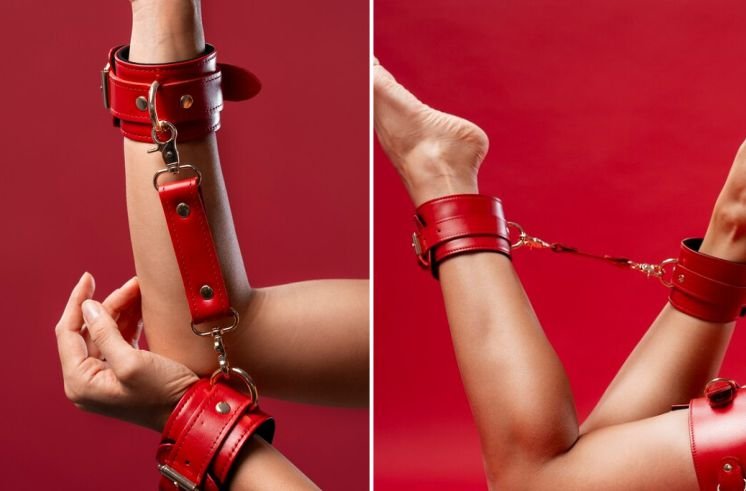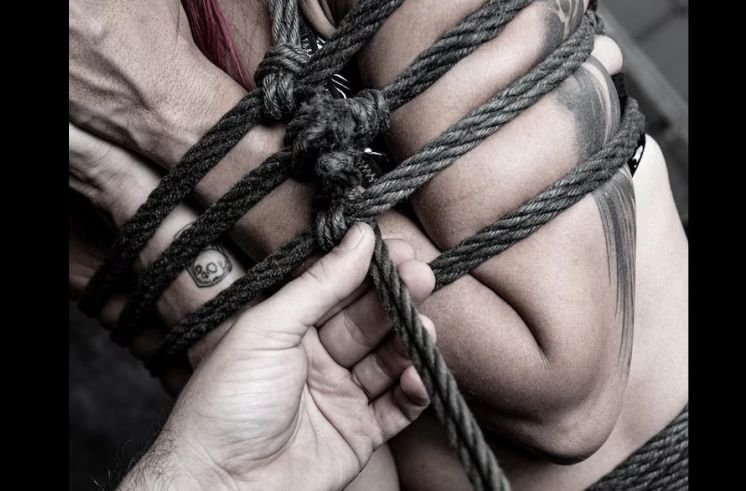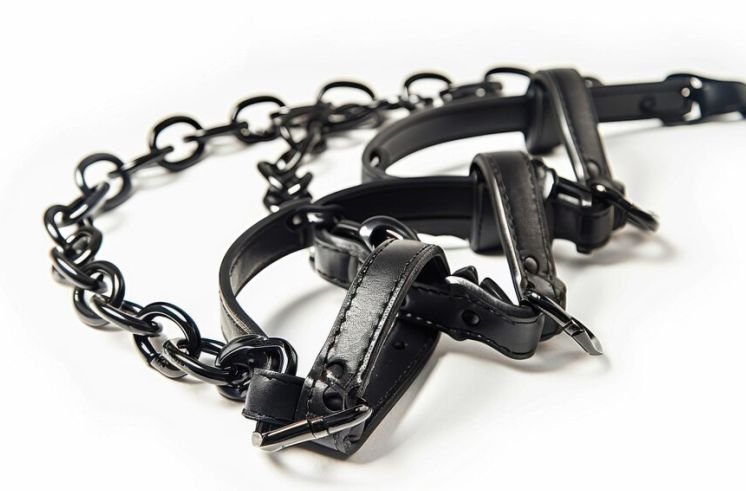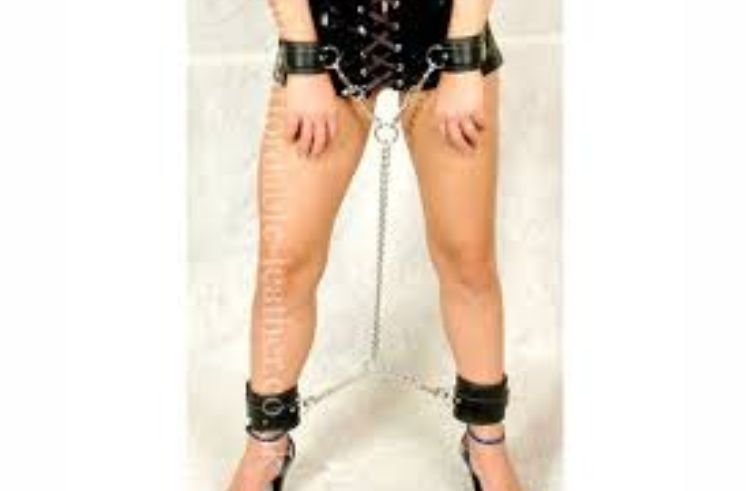Last updated on November 12th, 2025 at 05:06 pm
Master kink and BDSM restraints: explore types, safety, and play styles that challenge limits and amplify your power dynamics for an unforgettable experience.
Restraints are central to kink and BDSM, helping to shape power dynamics and enhance experiences between partners.
While BDSM focuses on control, dominance, and submission, kink is broader, covering a wide range of desires and activities.
BDSM restraints, like ropes, cuffs, and gags, are tools that create intense sensations and emotional connection, allowing you to step outside everyday roles.
The key to safe and enjoyable restraint play lies in clear communication, discussing boundaries, limits, and safe words before starting.
In this guide, we’ll break down different types of restraints beyond the basics and provide important safety tips.
Whether you’re just starting or looking to deepen your practice, this guide offers the knowledge to explore restraints confidently and safely, ensuring a fulfilling experience with your partner.
Main Points
- BDSM and kink restraints are tools that create vulnerability and enhance power dynamics, intensifying both physical and emotional connections between partners.
- Restraints in kink and BDSM can deepen trust, heighten sensory experiences, and enhance intimacy, promoting exploration of limits and new desires.
- Psychological restraints, such as verbal control and chastity devices, are used to manipulate behavior and create a mental submission dynamic, enhancing the emotional connection.
- The materials used for BDSM restraints, like leather, metal, and silicone, affect comfort, durability, and the intensity of the experience, requiring careful selection based on preferences.
What Are Kink and BDSM Restraints?
Restraints in BDSM and kink refer to various tools and techniques used to limit or control a partner’s movement, establishing a clear power dynamic between participants.
These can be physical restraints, like ropes, handcuffs, or bondage tape, which directly restrict movement, or psychological restraints, focusing on the mental aspects of giving up control.
The physical restraints allow one partner to set the pace and intensity of the experience, while psychological restraints deepen the emotional connection through anticipation and surrender.
Restraint play can spark trust, vulnerability, and heightened intimacy when done with clear communication and consent, helping both partners explore their desires safely.
What Are the Benefits of Kink and BDSM Restraints?
Kink and BDSM restraints offer several benefits that go beyond physical stimulation. When used safely and consensually, they can deepen trust, enhance intimacy, and unlock new levels of pleasure.
Here are five key benefits:
- Increased Trust: Engaging in restraint play requires open communication, fostering trust between partners as they navigate boundaries and safety protocols.
- Enhanced Sensory Experience: Restraints can heighten other senses by limiting movement, allowing you to focus more on touch, sound, and sensation.
- Emotional Connection: The vulnerability created through restraint can deepen emotional intimacy, leading to a stronger, more connected bond between partners.
- Heightened Power Dynamics: Restraints help clarify roles in power exchange play, intensifying the dominant and submissive aspects of BDSM relationships.
- Exploration of Limits: Restraints provide a safe way to test boundaries, allowing you and your partner to explore new desires and fantasies.
The Psychology of Kink and BDSM Restraints
BDSM restraints go beyond physical control, they tap into deep psychological dynamics that can transform the entire experience.
When you’re restrained, you may feel vulnerable or surrendered, emotions that can intensify the connection with your partner.
This vulnerability builds trust, a cornerstone of any BDSM scene. Both partners must rely on one another to respect boundaries and ensure safety, creating a foundation for deeper emotional exploration.
Trust and Control
In many cases, the psychological impact of restraints lies in the act of relinquishing control.
Being restrained might allow you to embrace the release of control, leaving you open to your partner’s actions and intentions.
This heightened emotional state can foster a deeper connection, creating a safe space for self-discovery and growth.
Communication Through Restraints
Restraints also serve as an effective communication tool. With clear discussions about limits, desires, and safe words, you and your partner can engage without fear of judgment.
These conversations help create a secure environment where both of you feel comfortable expressing your fantasies.
This trust and open communication make restraint play not only physically stimulating but also emotionally enriching.
Related Posts
- BDSM Bondage Restraints
- BDSM Torso and Chest Restraints
- Guide to Gagging in Kink and BDSM Play
- Bondage Tape Positions: Guide for BDSM Enthusiasts
- Bondage Tape Gag: How to Play Safely and Seductively
- What is Bondage Tape? A Beginner-Friendly Restraint
- BDSM Suspension Gear and How Does it Work?
Categories of BDSM Restraints
BDSM restraints come in many forms, each designed to enhance both the physical and psychological aspects of play. From simple to complex, these restraints help establish power dynamics, trust, and vulnerability.
Below, we’ll explore the key categories of BDSM restraints:
1. Physical Restraints
Physical restraints are central to many BDSM scenes, serving to restrict the submissive’s movements or position, heightening the experience of vulnerability.
These restraints can be simple or elaborate, and include various types of tools such as ropes, cuffs, spreader bars, and bondage tape.
They can range from the mild to the extreme, depending on the level of control desired.
Ropes, for example, offer versatility in positioning, while cuffs are often more restrictive.
Each type of physical restraint serves a specific purpose in altering the dynamics of power, reinforcing the submissive’s role, and making them more reliant on their dominant partner.
- Bondage Restraints: Limit movement and increase vulnerability using cuffs, ropes, or tape, enhancing helplessness and psychological intensity in safe, consensual BDSM play.
- Gags: Restrict verbal communication to intensify submission and mental control; commonly used are ball gags, bit gags, and ring gags.
- Hoods & Blindfolds: Remove visual or facial cues to deepen sensory focus and submission, enhancing trust and vulnerability through sensory deprivation techniques.
- Collars and Leashes: Symbolize control and ownership in power exchange, often used in pet play to guide, dominate, and reinforce D/s dynamics visually.
- Straitjackets and Sleepsacks: Offer total physical restraint, amplifying vulnerability and submission; ideal for advanced scenes emphasizing mental surrender and prolonged confinement.
- Furniture and Fixtures: Structures like bondage benches or crosses enhance restraint, scene control, and ritualistic intimacy by creatively limiting the submissive’s mobility.
- Harnesses: Worn on the body to restrict movement or enable suspension, they intensify physical restraint and emotional surrender in BDSM dynamics.
2. Psychological and Behavioral Restraints
Psychological restraints, though less physically restrictive, can be just as intense as their physical counterparts.
These restraints involve the use of language, mental control, and behavior modification to assert dominance and create submission.
Verbal restraints, for instance, may involve the use of specific phrases or commands that limit what the submissive can say or do.
Such verbal control often enhances the psychological aspect of the power dynamic, with the submissive being restricted mentally rather than physically.
These forms of restraint require a high level of trust between both partners, as they hinge on the emotional and mental boundaries of the submissive.
- Verbal and Protocol-Based Restraints: Use commands and structured rituals to control behavior and speech, reinforcing psychological submission and deepening dominance in BDSM dynamics.
- Chastity Devices: Prevent sexual pleasure and orgasm, increasing dependency and reinforcing the dominant’s authority over the submissive’s physical and emotional arousal.
- Humiliation and Roleplay Restraints: Use embarrassment, insults, or forced roles to induce mental submission and emotional vulnerability, strengthening psychological control in BDSM play.
Types of BDSM Restraints
BDSM restraints come in many forms, each designed to heighten control, submission, and psychological intensity.
To help you better understand their function and appeal, we’re grouping them into specific categories, each with its own unique role in kink and BDSM restraint play.
Whether you’re drawn to light bondage or full-body containment, this guide offers insight into the tools that shape scenes, deepen trust, and intensify power exchange dynamics in safe, consensual ways.
Here are the categories:
- Wrist and ankle restraints
- Rope-based restraints
- Furniture and positional restraints
- Full body restraints
- Specialty restraints
- Combination sets
Wrist and Ankle Restraints

Wrist and ankle restraints are foundational tools in BDSM that focus on immobilizing the limbs.
They’re widely used by both beginners and seasoned practitioners.
These restraints help create a sense of vulnerability and control, allowing partners to explore power dynamics safely and effectively during bondage or submissive play scenes.
1. Cuffs
Cuffs come in a range of materials such as leather, metal, Velcro, and fur-lined options.
Each material offers a unique sensation; leather is stylish and strong, metal is restrictive, Velcro is adjustable, and fur-lined adds comfort.
Cuffs are staples for restraint play, easily attaching to furniture, spreader bars, or each other.
2. Shackles
Shackles are heavy, typically metallic restraints that evoke a prison-like atmosphere.
They offer intense restriction and a psychological edge that can amplify feelings of helplessness and captivity.
Popular for roleplay and institutional fantasy scenarios, shackles create sensory contrast through their cold, hard material and audible clinking, adding realism and immersion.
3. Rope Tie
Rope bondage is one of the most versatile forms of restraint. Whether for decorative aesthetics or strict immobilization, it allows creative freedom.
Traditional Japanese Shibari or Kinbaku styles emphasize intricate knots and body harnesses, offering both physical and emotional intensity.
Ideal for those who appreciate artful, customizable, and deeply connected play.
4. Bondage Tape
Bondage tape adheres only to itself, not the skin, making it a painless and non-intimidating introduction to restraint.
It’s easy to apply, adjustable, and reusable, perfect for spontaneous or light bondage.
It’s especially popular among beginners seeking safe, non-marking restraint options that offer a balance of control and comfort.
5. Bondage Wrap / Plastic Wrap
Similar to industrial cling film, bondage wrap is used for mummification and sensory play.
It tightly hugs the body, restricting movement and increasing heat, pressure, and arousal.
Often used in combination with blindfolds or gags, it offers full-body immobilization while still being accessible and low-cost for home scenes.
6. Restraint Belts
Restraint belts wrap around the waist and secure limbs in specific positions, often inspired by institutional or medical gear.
They’re perfect for psychological roleplay scenarios, allowing partners to explore strict control with an aesthetic edge.
Some designs include additional attachments for locking arms or legs in place for full restraint.
Rope-Based Restraints

Rope-based restraints blend artistry with control, offering a sensual and aesthetic approach to bondage.
From traditional Japanese Shibari to functional quick-release ropes, each style invites creativity, connection, and intentional restraint.
These techniques range from decorative ties to full immobilization, enhancing both visual impact and intimate power exchange.
1. Shibari Rope / Kinbaku Rope
These traditional Japanese ropes are typically made from natural fibers like jute or hemp. They’re used to create intricate, sensual, and artistic bondage patterns.
Shibari and Kinbaku emphasize connection, form, and restraint, blending pain, beauty, and submission in a culturally rich and aesthetically driven experience that’s emotionally and physically intense.
2. Hemp, Cotton, Jute Ropes
Each rope material brings a unique texture and flexibility. Hemp and jute are rough and durable, ideal for advanced players and traditional bondage.
Cotton is softer and more forgiving, perfect for beginners. These ropes vary in stretch and strength, allowing users to select the best fit for their comfort and play style.
3. Quick-release Bondage Ropes
Quick-release ropes are designed for ease of use and enhanced safety.
They include built-in clips or fast mechanisms that allow instant removal, making them excellent for emergencies.
These ropes are beginner-friendly, offering the thrill of bondage while maintaining confidence and peace of mind for those new to restraint play.
4. Rope Harnesses
Rope harnesses, whether DIY or pre-made, wrap around the torso, hips, or full body.
They combine visual appeal with physical restraint and can double as wearable kink gear.
Often used in fashion, performance art, and bedroom scenes, they offer both form and function in restraint with creative customization.
Furniture & Positional Restraints

Furniture and positional restraints are designed to hold the body in specific poses, intensifying vulnerability and dominance dynamics.
From spreader bars to bondage chairs, these tools offer structural support for extended scenes, heighten anticipation, and create immersive physical and psychological experiences that elevate restraint play to new levels.
1. Under-the-bed Restraint Systems
These discreet systems fit beneath any mattress and include adjustable straps and cuffs to secure wrists and ankles.
They create a spread-eagled bondage position without permanent fixtures.
Ideal for spontaneous scenes or shared living spaces, they’re portable, easy to hide, and incredibly effective for positional control and psychological submission.
2. Spreader Bars
Spreader bars keep the limbs apart and in place, maintaining vulnerability and openness.
Commonly used for both wrist and ankle restraint, they are made from wood, metal, or adjustable plastic.
They’re great for keeping partners exposed, amplifying sensation and accessibility during impact play, teasing, or extended submissive positioning.
3. Bondage Chairs / St. Andrew’s Cross
These iconic BDSM furniture pieces secure the submissive upright or seated. The St.
Andrew’s Cross allows full-body restraint with arms and legs spread.
Chairs offer a stable seated option for bondage or teasing. Both are ideal for public scenes, impact play, or intense psychological submission with full exposure and control.
4. Restraint Benches / Tables
These pieces of bondage furniture provide flat or angled surfaces where a submissive can be bound securely.
They often include padding, loops, or straps for comfort and safety.
Used for long-term scenes or impact play, they’re designed for total immobilization and enhanced access, making control easy and sustainable.
5. Adjustable Stocks
Adjustable stocks restrain the neck, wrists, or ankles using wooden or metal frames, similar to medieval punishment devices.
They’re perfect for humiliation play, historical fantasy, or public display scenes.
Their restrictive design offers no wiggle room, promoting helplessness and psychological surrender, while enhancing visual drama and scene intensity.
Full Body Restraints

Full body restraints provide intense immobilization, enveloping the entire body for heightened submission and control.
These restraints often incorporate sensory deprivation elements, such as mummification wraps or vacuum beds, and are ideal for long-duration play.
They intensify physical sensation, psychological submission, and a deep sense of helplessness for both partners.
1. Body Harnesses
Body harnesses encompass the torso, hips, or full body with materials like rope, leather, or neoprene.
They offer varying levels of restriction depending on design and tightness.
These full-body systems can be both functional and decorative, used in scenes that explore fashion, fetish, immobilization, or sensory stimulation across the body.
2. Straitjackets
Straitjackets are powerful restraint tools that symbolize complete loss of control.
Common in medical or psychological roleplay, they fully restrict arm movement and often incorporate straps around the chest, back, and thighs.
They evoke deep submission, making them ideal for scenes focused on helplessness, confinement, and total power exchange.
3. Sleep Sacks / Bondage Bags
These enclosures fully encase the body, usually with zippers, locks, and internal padding. Sleep sacks and bondage bags restrict movement, limit sensory input, and trap body heat.
Often used for long-term or sensory deprivation bondage scenes, they promote stillness, submission, and a meditative state through total containment.
4. Cocoon or Mummification Wraps
This technique involves encasing the body in layers of plastic wrap, duct tape, or latex sheeting.
It creates a tight, immobilizing cocoon that restricts movement, airflow, and sensory input.
Perfect for deep subspace experiences, mummification enhances helplessness and heightens sensitivity through pressure, heat, and total bodily confinement.
5. Vacuum Beds
Vacuum beds consist of latex sheets sealed around the body, with air suction creating tight compression.
They offer extreme immobilization and powerful sensory play. The visual of a partner encased in latex, fully restrained and unable to move, provides intense stimulation and psychological depth in futuristic or latex-themed scenes.
Specialty Restraints

Specialty restraints cater to specific kinks and roleplays, offering unique ways to enhance experiences.
These tools are designed to target particular sensations or fantasies, such as thumb and toe cuffs for increased restriction or collar and leash sets for power dynamics.
They push boundaries and elevate customized play scenarios.
1. Thumb and Toe Cuffs
These miniature restraints are designed to bind smaller body parts like thumbs and toes.
Though small, they’re highly effective for enhancing sensitivity and reducing movement.
Used in detailed control play or to heighten sensation in targeted areas, they add a subtle yet significant layer of restriction to scenes.
2. Puppy Play Mitts / Paw Restraints
These mitts eliminate hand functionality and simulate paws, reinforcing submissive roles in pet play.
Padded and often designed to mimic animal limbs, they create a sense of dehumanization and helplessness.
Ideal for roleplay involving obedience, degradation, or affection-based dynamics where partners act as animal companions or handlers.
3. Collar and Leash Sets
Collars and leashes are symbolic restraints that represent ownership, obedience, and dominance.
The collar wraps around the neck and can be attached to a leash for physical guidance or control.
They’re popular in D/s dynamics, both inside and outside play scenes, reinforcing power structures and psychological connection through simple restraint.
4. Head Harnesses
These devices wrap around the head using leather or silicone straps. They’re used to secure gags, blindfolds, or hoods, and can limit jaw movement or sight.
Often seen in intense scenes or sensory play, head harnesses amplify vulnerability and focus by restricting communication and increasing psychological surrender.
5. Gags with Integrated Restraints
These multifunctional tools combine mouth gags with attached wrist cuffs, collars, or chest harnesses.
They add layers of control, making speech impossible while simultaneously restraining limbs.
Perfect for those who want a unified restraint experience, they’re efficient, aesthetically impactful, and intensify scenes through combined physical and psychological domination.
6. Bondage Hoods with Internal Restraints
These hoods fully enclose the head, often blocking vision, hearing, and speech. Some models feature built-in gags, blindfolds, or breathing tubes for extended deprivation.
Bondage hoods create intense psychological and sensory experiences, immersing the submissive in darkness, silence, and helplessness for powerful scenes centered on loss of identity.
Combination Sets

These restraint kits combine multiple elements, ideal for experimenting or enhancing variety.
1. Wrist-to-Ankle Cuffs
These cuffs link wrists to ankles, usually in a kneeling or curled position. This posture enhances submissiveness and vulnerability, making it perfect for pet play, dollification, or humiliation scenarios.
The restraint limits movement and imposes powerlessness, creating an impactful dynamic with physical control and deep emotional resonance.
2. Hogtie Sets
Hogtie sets bind the wrists and ankles together behind the back or underneath the body, severely limiting mobility.
Whether using rope or pre-made straps, they are perfect for advanced restraint.
This position can induce psychological surrender and vulnerability while offering clear visual cues of complete submission and helplessness.
3. Collar-to-Wrist or Collar-to-Ankle Connectors
These devices link the collar to cuffs at the wrists or ankles, keeping limbs close to the body and preventing extension.
This form of restraint increases vulnerability and physical limitation, reinforcing dominance and submission roles.
They’re great for maintaining posture, restricting movement, and enhancing control in various scenes.
4. Bondage Kits
Bondage kits are all-in-one packages containing essentials like cuffs, blindfolds, gags, ropes, and sometimes floggers.
They’re perfect for beginners or couples looking to explore restraint play with convenience and safety.
These sets provide a variety of tools to experiment with different dynamics, sensations, and bondage techniques in a single bundle.
Extreme BDSM Restraints
Extreme BDSM restraints push the boundaries of traditional bondage, offering intense physical and psychological experiences.
These restraints typically involve full-body immobilization and sensory deprivation, creating a heightened sense of helplessness and vulnerability.
Tools such as straitjackets, vacuum beds, and mummification wraps effectively restrict movement, often trapping heat, air, or sensation.
These restraints are used in more advanced scenes to deepen submission or dominance dynamics.
They may also include gags, hoods, or blindfolds to limit sensory input, further enhancing control.
Extreme BDSM restraints cater to those seeking intense experiences with a focus on psychological control, safety, and trust.
These tools are particularly suited for kinksters who enjoy exploring deep power exchange dynamics, fetish play, and long-term bondage scenarios, emphasizing complete confinement and isolation for heightened pleasure and control.
Materials Used in BDSM Restraints
When exploring BDSM restraints, the materials used play a key role in shaping your experience.
Different materials offer different sensations, comfort levels, and durability, so it’s important to understand how each one impacts your practice.
Leather Restraints
Leather is a popular choice for BDSM due to its durability and sensual appeal. It ages well, developing a unique patina over time, but may require maintenance.
Leather can cause discomfort if not fitted correctly and may not suit those with sensitive skin.
Metal Restraints
Metal restraints, such as those made from stainless steel or aluminum, offer a firm and rigid form of bondage.
They provide a secure, unyielding feel but can be cold against the skin and harder to adjust. They’re best for those who enjoy a fixed, heavy restraint.
Silicone and Rubber Restraints
Silicone and rubber restraints are softer on the skin, making them comfortable and flexible, especially for beginners.
These materials are easy to clean and come in various colors and designs. However, they may not be as durable or offer the same level of control as leather or metal.
Rope Bondage
Rope is a versatile and creative restraint, allowing for a wide range of bondage styles.
Synthetic fibers like nylon offer strength, while natural fibers like cotton and jute provide a more organic feel.
However, improper knotting can lead to safety risks, so caution is necessary.
Matching Restraints to Play Styles
In BDSM, the type of restraints you choose depends on the dynamics of your play.
Understanding how your role and preferences affect restraint choices ensures both safety and enjoyment.
Let’s break down how different play styles influence restraint choices.
Dominance and Submission (D/s)
If you’re into D/s dynamics, restraints help emphasize power exchange. Cuffs, ropes, and harnesses are common choices.
Leather or soft fabrics can add comfort or challenge based on what you and your partner prefer.
The right restraint highlights vulnerability while enhancing your experience.
Sadomasochism
Sadomasochism mixes pleasure with pain. The type of restraint you use will depend on the intensity you want to control.
Adjustable cuffs or bondage tape are great for impact play. These restraints allow quick adjustments to shift between comfort and discomfort, keeping the experience thrilling.
Role-Playing Scenarios
Restraints also play a big role in role-playing. For pet play, collars and leashes emphasize submission, while doll play calls for rigid restraints to create a lifeless, controlled look.
Choose the restraints that match your scene’s theme to keep the experience authentic.
Solo vs Partnered Play
Solo play may call for different restraint types than partnered play. In partnered sessions, communication is key.
Always discuss boundaries and safety precautions before using restraints, ensuring both partners are comfortable and the scene remains enjoyable.
Choosing the Right Restraints for You
When you’re diving into BDSM, picking the right restraints is key to making the experience both safe and enjoyable.
The first step? Open communication with your partner. Talk about your preferences, limits, and any concerns you may have.
Setting clear boundaries creates trust, which is crucial for a positive restraint experience. Here are ideas to help you:
Know Your Comfort Zone
Everyone reacts differently to materials and types of restraints. Beginners might want to start with softer, simpler options like fabric cuffs or bondage tape.
These are flexible and easy to remove, which can make you feel more comfortable.
As you gain more experience, you may want to explore restraints made of leather or metal, which offer a different sensation and greater control.
Start Light, Explore Gradually
If you’re new to restraints, it’s best to start slow. Introduce one restraint at a time to get used to the feeling.
This lets you build confidence and comfort over time. Make sure to check in with each other frequently during the scene.
What feels good at first might turn uncomfortable, so be mindful and ready to adjust as needed.
Prioritize Safety and Trust
As you try different restraints, remember that the most important part is your partner’s safety and comfort.
Use safe words, and make sure you’re both on the same page about what’s okay and what’s not.
This will help keep the experience enjoyable and within both of your limits.
Aftercare for BDSM Restraint Play
Aftercare is a key part of BDSM, especially after restraint play, which can trigger strong physical and emotional reactions.
It’s about looking after your partner’s well-being, both emotionally and physically, once the scene is over. The goal is to ensure comfort, safety, and connection.
Emotional Check-ins
After the scene, it’s important to talk about how each of you is feeling. This helps process the experience and strengthens your bond.
Sharing thoughts and discussing physical sensations can build trust and understanding.
Make sure to be empathetic and supportive, acknowledging both the highs and lows of the play.
Physical Care
Restraint play can leave you feeling sore or tired, so physical care is essential. A gentle massage can help ease muscle tension, while hydration is key for recovery.
Offering water or electrolyte drinks can help your partner feel better after a physically demanding scene.
Cleaning Restraints
Taking care of your restraints is important, too. Cleaning them properly helps prevent infections and ensures they last longer.
Different materials need different cleaning methods, so always follow the instructions for the gear you use.
Antibacterial wipes or gentle cleansers can keep everything safe and in good condition.
Common Misconceptions About BDSM Restraints
There are a lot of myths surrounding BDSM restraints that can make people uncomfortable or misinformed.
Let’s clear up some of these misconceptions to help you understand BDSM better and engage in practices that are safe and consensual.
BDSM Restraints and Consent
One common myth is that BDSM, including the use of restraints, involves a lack of consent.
In reality, BDSM is based on mutual consent. Everyone involved has agreed on their limits, boundaries, and preferences before anything happens.
Consent is always prioritized to ensure that everyone feels comfortable and is participating willingly.
BDSM Restraints Are Dangerous
Another misconception is that BDSM restraints are dangerous by nature. While any physical restraint carries some risk, responsible practitioners know how to use restraints safely.
This includes choosing the right materials for the activity and understanding the importance of safe words or signals to communicate boundaries.
Being aware of the risks and knowing how to manage them is key to creating a safe and enjoyable experience.
Psychological Issues and BDSM
Some people think that those who participate in BDSM practices have psychological problems or are trying to escape reality.
This simply isn’t true. Many people engage in BDSM for emotional connection, trust, and intimacy.
Far from being an unhealthy escape, BDSM can strengthen relationships, improve communication, and promote closeness.
Tips for Beginners in BDSM Restraint Play
If you’re new to BDSM restraint play, it’s important to approach the experience with both excitement and care. Here are some key tips to help you get started safely and confidently.
Open Communication is Key
Before anything else, talk with your partner about what you both enjoy, your limits, and what’s off-limits.
Discussing safe words and how to communicate during the experience is also essential.
This helps establish trust, ensuring both of you feel comfortable and respected throughout the session.
Create the Right Environment
Choose a private space where you can both focus without interruptions. Make sure it’s comfortable with proper lighting and temperature control.
Keep any necessary tools nearby, such as safety scissors, in case you need to release restraints quickly.
Start Simple with Restraints
As a beginner, start with softer, more adjustable restraints like bondage cuffs or silk ties.
These will give you a gentler introduction to restraint play. Over time, as you become more comfortable, you can experiment with sturdier materials like leather or metal, but always prioritize safety.
Don’t Skip Aftercare
After restraint play, take the time to check in emotionally with your partner and offer support.
Aftercare is just as important as the play itself, as it helps reinforce trust and intimacy.
Discuss the experience, make sure both of you feel secure, and care for any physical needs that may have arisen during the session.
Frequently Asked Questions
What are BDSM restraints used for?
BDSM restraints help control a partner’s movement, creating a power dynamic that enhances emotional and physical connection. They include ropes, cuffs, and psychological restraints to deepen intimacy.
Are BDSM restraints safe to use?
When used responsibly with clear communication and consent, BDSM restraints can be safe. Ensure proper materials are chosen, boundaries are respected, and safe words are established for safety.
What types of restraints are common in BDSM?
Common BDSM restraints include ropes, cuffs, gags, hoods, and collars. Each type emphasizes a different aspect of control, whether physical or psychological, depending on the scene’s dynamics.
How do I choose the right restraints for BDSM play?
To choose the right BDSM restraints, communicate your preferences and limits with your partner. Consider materials, comfort, and the intensity of control you wish to experience for a safe play.
Conclusion
Exploring BDSM restraints involves understanding both physical and psychological dynamics.
From ropes and cuffs to verbal control, each type of restraint serves a unique purpose, deepening the trust and connection between partners.
Safety and communication are key, ensuring that both partners are aware of their boundaries and desires.
Whether you are a beginner or experienced, choosing the right restraints, along with aftercare, is essential for a fulfilling and respectful experience.
Always prioritize consent, respect each other’s comfort zones, and approach restraint play with care for a safe and exhilarating journey.
References
- ResearchGate: The Psychology of Kink
- GrandViewResearch: U.S. BDSM Sex Toys Market Size To Reach $2.4 Billion By 2030
Pyo Merez is a respected author and one of the backbones of our review board. He is an advocate in the BDSM community, known for his insightful writings and dedication to educate and empower individuals about the dynamics of BDSM. His work covers various aspects of BDSM, emphasizing open communication, consent, and healthy boundaries. Through online platforms, workshops, and speaking engagements, Pyo creates a non-judgmental space for individuals to freely express themselves and explore BDSM responsibly. His work has helped many people navigate their journeys and fostered understanding and appreciation for BDSM.
